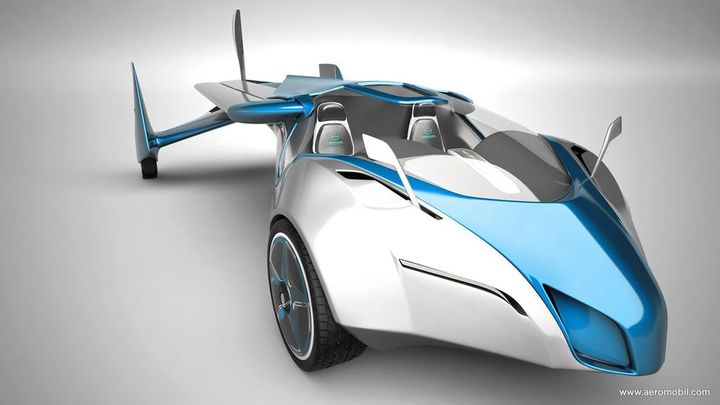
When it comes to the broken promises of the 21st century, the flying car is considered the greatest of betrayals. For those of us growing up in the ’80s, movies and television promised us a future of automobile-filled skies. But much like commercial space flight and trips to the Moon by 2001, it seems that this promise may finally be close to full-scale realization.
Take the Aeromobil 3.0, a flying car prototype developed by a Slovakia-based aerospace company that is capable of being converted from an automobile to a prop-driven aircraft. The result of 20 years of engineering by Slovak designer Štefan Klein and Juraj Vaculik, this prototype flying car made its first debut in April of 2007 at the AERO-EXPO in Friedrichshafen, Germany.
Since that time, the design has undergone multiple upgrades, was featured at three additional aerospace congresses and expos, and appeared on a segment of TEDx in Bratislava. In September of 2013, the prototype 2.5 model appeared at the Montreal SAE AeroTech Congress and Exhibition, and then made its first-ever test flight later that year.
The 3.0 prototype will be presented to the world this next week (Oct 29th) at the Pioneers Festival in Austria. Unlike the previous versions, the wings fold into the backseat behind the driver; a somewhat inelegant solution, but one which demonstrably works. The current design holds two people, allegedly flies up to 692 km/h (430 mph), and runs on standard gasoline.

No information has been provided on pricing or when the plane would become commercially available just yet, but as the demonstration video of the 2.5 attests, the technology works. And not too surprisingly, Aeromobil is not alone in wanted to develop a working, aeronautical automobile.
Terrafugia and Moller International are also developing their own prototypes. The former is a private aerospace company made up of award-winning MIT-trained engineers and MBAs. Founded in 2006, they were one of three award winners in the MIT $100K Business Plan Competition. Their prototype car, the TF-X, is currently under development, and no indication is yet available on when it might be available.
On the other hand, Moller International has already produced a working prototype and is seeking FAA approval and crowdsourcing the necessary funds to conduct the necessary tests to bring it to market. Created by aerospace inventor Paul Moller, who has been working in aerospace for the past thirty years, the prototype vehicle - known as the M400X (aka. Skycar), - this car is a vertical take-off and landing vehicle that is also capable of horizontal flight.
Powered by eight ethanol-fueled engines, it is designed to cruise at a speed of 500 km/h (315 mph) at an altitude of 7600 meters (25,000 feet), or 320 km/h (200 mph) at sea level. A four-seat model that is about the size of a large SUV, this car weighs only 545 kilograms (1,200 lbs), thanks to its carbon fiber and Kevlar composite shell.

Naturally, there are a few stumbling blocks with all of these ideas, not the least of which is FAA approval and the cost per unit. In addition, if and when such vehicles become more common, we can expect that only those people with a valid pilot’s license and driver’s license will be allowed to operate one. On top of that, there are some voices of dissent who think flying cars are simply not a good idea.
One such individual is the venerable Elon Musk. As the founder/owner of Tesla Motors and SpaceX, Musk is heavily invested in alternative energy and space exploration. But when it comes to flying cars, he’s taking a pass. As he explained during a recent appearance on Vanity Fair New Establishment Summit:
"I'm not sure about the flying cars. If the sky was full of cars flying all over the place, it would affect how things look. It would affect the skyline. And it would be noisier and there would be a greater probability of something falling on your head. Those are not good things.”
Still, he acknowledged that a sky full of flying cars (preferably Teslas!) would have its advantages. These would include speedier travel, and how combining it with other measures - like a giant system of underground tunnels – could eliminate traffic “choke points”, which would ease and simplify the problem of commuting.
In any event, the case for flying cars has yet to be fully assessed. But we’re certainly making progress. From time to time, we must remind ourselves that all game-changing inventions began with a proof-of-concept before all the issues were worked out. And even if a flying car does come with a lot of red tape and costs times what an automobile currently goes for, prices are likely to come down as the technology becomes more mainstream and demand rises.
As such, we can reasonably expect to see at least a few flying automobiles overhead in the coming decades. How’s that future looking now? More or less on track?
Video:
Sources:
- www.aeromobil.com/video
- www.engadget.com/2014/10/07/flying-car-aeromobil/
- www.terrafugia.com/tf-x
- moller.com/dev/index.php/sky-car/m400-specs
- www.fastcocreate.com/3021210/you-can-ride-shotgun-in-this-flying-car-for-a-crowdfunded-contribution
- www.indiegogo.com/projects/actually-fly-the-m400x-skycar-into-history








